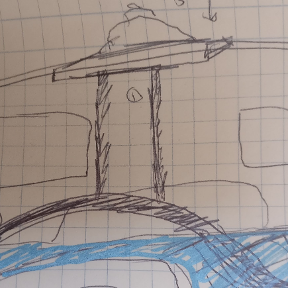Welcome to the Onshape forum! Ask questions and join in the discussions about everything Onshape.
First time visiting? Here are some places to start:- Looking for a certain topic? Check out the categories filter or use Search (upper right).
- Need support? Ask a question to our Community Support category.
- Please submit support tickets for bugs but you can request improvements in the Product Feedback category.
- Be respectful, on topic and if you see a problem, Flag it.
If you would like to contact our Community Manager personally, feel free to send a private message or an email.
Equation driven parabolas?
 Nickolas_Lockard
OS Professional Posts: 36 ✭✭
Nickolas_Lockard
OS Professional Posts: 36 ✭✭
in Drawings
Hi,
How can I create equation-driven parabolas? I have to pack parabolic mirrors in a packaging array and check for part interferences and assess other parts of model. I want to create 2 mirrors. Each is a segment of a parabola inner closer to origin and outer further away) Size is 4mm thick, 1.5m X 1.9m. I learned a hard way to do this in SW, but surely there is a way in Onshape? I just can't find anything searching and reading here or watching videos.
Thank you kindly for your help!
Nick
How can I create equation-driven parabolas? I have to pack parabolic mirrors in a packaging array and check for part interferences and assess other parts of model. I want to create 2 mirrors. Each is a segment of a parabola inner closer to origin and outer further away) Size is 4mm thick, 1.5m X 1.9m. I learned a hard way to do this in SW, but surely there is a way in Onshape? I just can't find anything searching and reading here or watching videos.
Thank you kindly for your help!
Nick
Tagged:
0
Best Answers
-
 andrew_troup
Member, Mentor Posts: 1,585 ✭✭✭✭✭
Using a variable would still rely on creating a spline and snapping coordinate dimensions to control points (most easily with a construction grid as mentioned), then you would have to create a separate variable for each control point, because each Onshape variable can only take one value at any one time. Moreover they cannot derive their input simply by selecting a control point, so you would then have to manually input the x ordinate into the variable equation ... so it would be considerably more, rather than less, laborious, than an external spreadsheet. (The spreadsheet can be filed in the 'project container')
andrew_troup
Member, Mentor Posts: 1,585 ✭✭✭✭✭
Using a variable would still rely on creating a spline and snapping coordinate dimensions to control points (most easily with a construction grid as mentioned), then you would have to create a separate variable for each control point, because each Onshape variable can only take one value at any one time. Moreover they cannot derive their input simply by selecting a control point, so you would then have to manually input the x ordinate into the variable equation ... so it would be considerably more, rather than less, laborious, than an external spreadsheet. (The spreadsheet can be filed in the 'project container')
What I forgot to mention was that, if you need an optically smooth result, tangency controls might have to be tweaked to sweeten the curvature combs (depending how many points there are), which would make it a genuinely laborious endeavour with the current toolset.
What would *really* fast-track this task would be sketch conics, as requested here:
https://forum.onshape.com/discussion/189/can-we-have-a-sketch-conic5 -
 ilya_baran
Onshape Employees, Developers, HDM Posts: 1,248
ilya_baran
Onshape Employees, Developers, HDM Posts: 1,248  The day when we support equation-driven or data-driven curves is not yet upon us, but also not too far away.
The day when we support equation-driven or data-driven curves is not yet upon us, but also not too far away.
For now, another approach is to use the fact that all parabolas are actually the same up to rigid motion and uniform scale. So I would construct, say a 45 degree cone, split it with a plane parallel to one of the sides, and then figure out the focus and directrix and transform the parabola to match the desired parameters.Ilya Baran \ VP, Architecture and FeatureScript \ Onshape Inc5
Answers
There's no current facility for importing coordinates from an external file, or creating curves through such a list.
What I forgot to mention was that, if you need an optically smooth result, tangency controls might have to be tweaked to sweeten the curvature combs (depending how many points there are), which would make it a genuinely laborious endeavour with the current toolset.
What would *really* fast-track this task would be sketch conics, as requested here:
https://forum.onshape.com/discussion/189/can-we-have-a-sketch-conic
Hey, it is one way.
Ingenious suggestion.
I can imagine it working well enough in Solidworks, but setting tangencies at spline control points in Onshape is not a lot of fun, at the present early stage of constraint management.
This is made more difficult still by the plethora of coincident constraints, because there are no 'merge' constraints for shared endpoints.
I'm sure the former of these will be addressed soon, and I hope the latter problem will be dealt with in due course.
For now, another approach is to use the fact that all parabolas are actually the same up to rigid motion and uniform scale. So I would construct, say a 45 degree cone, split it with a plane parallel to one of the sides, and then figure out the focus and directrix and transform the parabola to match the desired parameters.
Since you are making packaging to cradle a product can you get an accurate solid model of the product itself? You could than use its dumb geometry to define your packaging geometry.
That's what I need an accurate model of just to accurately assess static fitment in the package, then later to check for vibration/movement/momentum behaviors, etcetera during package transit.
I've been going back and forth using Excel which isn't very good, frankly, and looking at a colleague's ACAD model. ACAD is just too hard to use and I have to be able to visualize 3D solid model to make this work.
Can you point me to a tutorial or video of how to do this? I have tried your method, but I'm stuck. How do I make a plane parallel to a side?
https://cad.onshape.com/documents/4fc8db0dd6784195948b4339/w/805ed239e25d4419831b6f20/e/981d1afa94254c11a098194c
That part is from colleague's AutoCAD generated file and isn't true parabola--it's constructed from splines, I think.
You can extract the geometry of this (or any) edge by starting a new sketch on a plane parallel to the cut face, picking the parabolic edge, and choosing "Use/Project"
That sketch can then be transformed, derived, etc etc.
wonderfully economical demo model ! Nice .....
https://cad.onshape.com/documents/d8aab1e0e7ae10038a6830e0/w/9dfdd631d025960813b8f2df/e/621b5be97d38074a1f1546e5
https://cad.onshape.com/help/Content/conic.htm